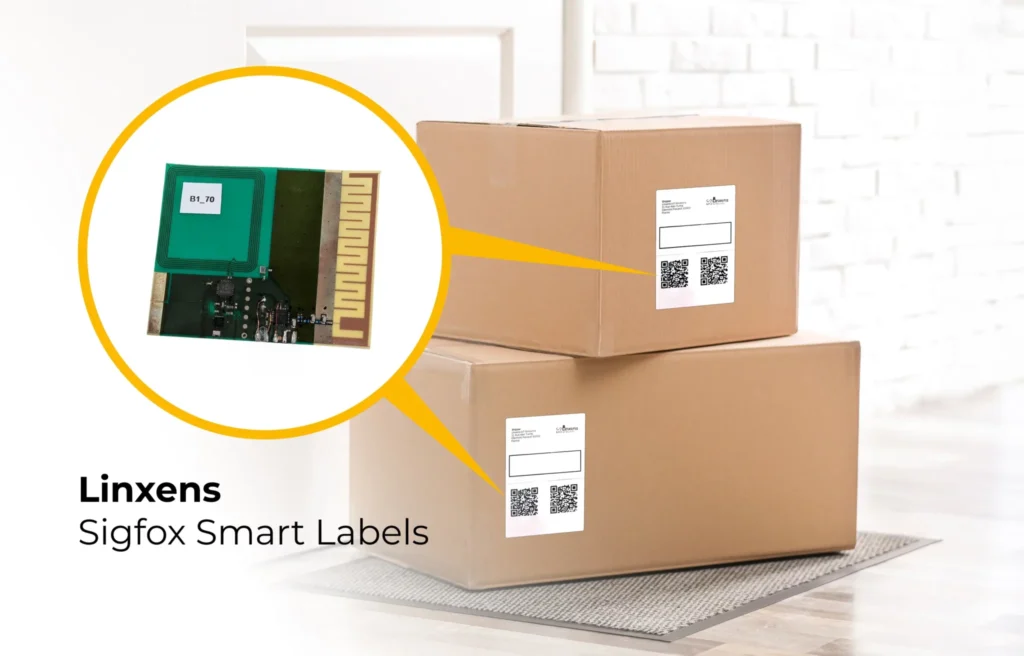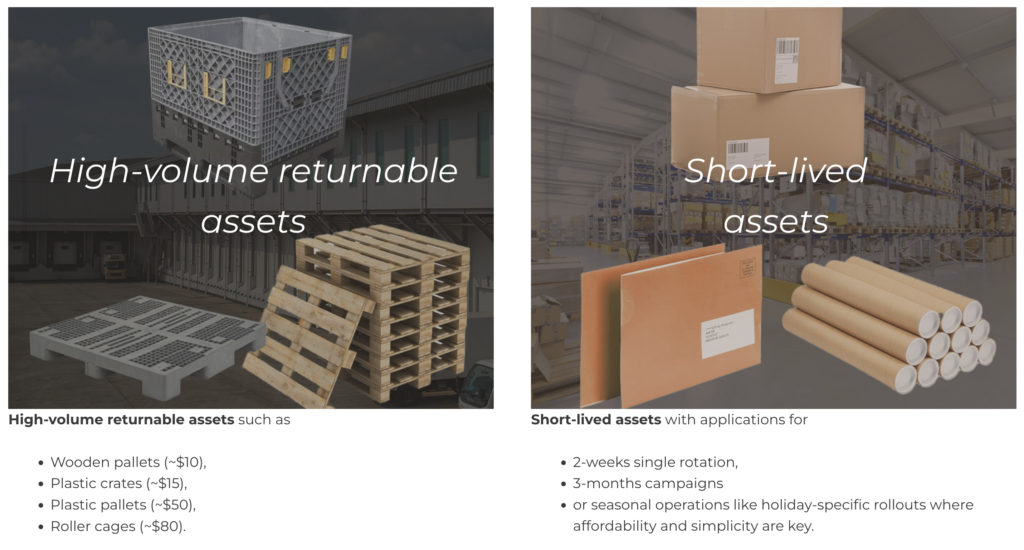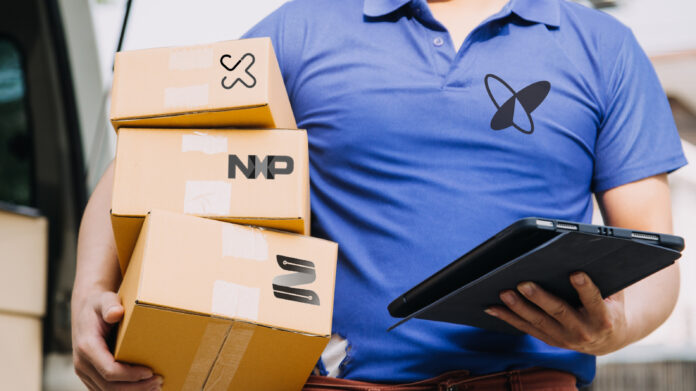Sigfox parent UnaBiz has convened a new ‘Sub0G’ ecosystem collective to develop smart IoT labels for the low-end of the IoT tracking market, targeting logistics and distribution sectors. French electronics manufacturer Linxens, Dutch semiconductor company NXP Semiconductors, and UK printed battery maker Zinergy have all signed up. The move follows on the heels of a Linxens showcase at CES earlier this month, where it was hawking a new multi-mode IoT label with support for wide-area Sigfox, mesh-based Wirepas, and general satellite IoT connectivity (see image below).
As discussed, the IoT market is pushing smart labels in serious fashion at the start of 2025, in a bid to make IoT tech viable for everyday asset tracking in the supply chain, and to make good on the long-held promise of ‘massive IoT’ – where it is sufficiently cheap and powerful, as well as sustainable (whether recyclable or disposable), for spiralling commercial scale. Smart labels, printable silicon-and-SIM stickers that connect even low-value parcels to IoT networks, have been around as proofs-of-concept for years; there is a sense, now, that they will properly catch on.
The new Sub0G programme is describUnabied as a “subcategory of the Sigfox 0G protocol”. (‘Sigfox 0G’ is the branding the Singapore-based firm has continued with since it acquired the ‘ultra-narrowband’ Sigfox technology in 2022.) It is not just about environmentally-engineered smart IoT labels, which somehow use printable bio-sourced plastics (from bio-degradable fish scales and such) and other recyclable componentry; the focus, in the first instance, is to enable dirt-cheap (“cost-efficient, entry-level”) new IoT rackers to attach to “returnable and short-lived assets”.

These assets, as per the project’s remit, include: “returnable and short-lived assets, including $5 cardboard boxes for valuables, $10 wooden pallets, $15 plastic crates, $50 plastic pallets, and $80 roller cages”. Some of these assets have been connected quite successfully already with standard ‘0G’ Sigfox solutions, notably roller cages for postal services in Europe. In a statement, UnaBiz said there are over 155 million plastic KLT (‘kleinladungsträger’, or ‘small load carrier’) crates, as used commonly in the automotive supply chain, in circulation today.
Other unattributed market stats say the global market for returnable packaging was worth $123 billion in 2024, and will reach $209 billion by 2033 – growing at a compound annual rate (CAGR) of about six percent in the period. It is a significant and rather-untapped market – is the message. But the smart-label angle is (always) the most interesting – on the grounds it promises massive scale, potentially, some kind of environmental sustainability, ideally. Otherwise, The IoT movement, supposed to save the planet, is just destroying the planet.
An EU-funded group of IoT researchers and agitators said in 2023 that 78 million-odd batteries from battery-powered IoT devices will be dumped globally every day by 2025 (!!!) – if nothing is done about it. In the end, the deployment of masses of (mostly) battery-powered sensor devices undermines the sector’s green promise to enable large-scale industrial energy savings, alongside sundry business insights. The new smart label from Linxens appears like a step in the right direction, as do parallel efforts variously from Giesecke+Devrient (G+D) and Sensos, most notably.
(Although all of their green creds should be properly checked, clearly.) UnaBiz makes reference to the sustainability upside of the Sub0G initiative, but it is mostly about the green impact of smarter business, gained from acting on operational insights from IoT tracking and monitoring solutions – rather than the provenance and consequence of immediate massive-scale production of mini-electronics gadgetry. The programme addresses enterprise challenges around “sustainability objectives, regulatory requirements, and ESG reporting frameworks,” it said.

All the same, smart IoT labels, as per the new Sigfox-based Linxens product, are a focus, too. Linxens is lined up to contribute advanced roll-to-roll manufacturing to the initiative (“with capacity to produce millions of flexible labels annually”); NXP is “among the first collaborators”, recruited to help with “secure connectivity solutions for embedded applications”; Zinergy, crucially, will provide “lithium-free, environmentally safe, non-toxic” printed batteries. Unabiz talked about “energy-efficient IoT… [to enable] net-positive digital transformation”, and invited collaboration.
Alexis Susset, group chief technology officer at the firm, commented: “The Sub0G programme represents a new chapter for Sigfox 0G technology, combining sustainability, cost efficiency, innovation, and scalability. Backed by software-driven radio networks and advanced cloud services, it enables sustainable IoT deployments. Our programme fosters strategic partnerships to advance cost and energy-efficient IoT solutions, enabling net-positive digital transformation. We invite organisations to collaborate on shaping sustainable and effective IoT strategies.”
As well as the innovation with printed batteries for sticky labels, the focus is on wide-area IoT, and the quest to topple short-range IoT tech, and also on AI, of course, and the drive for more data points to run-through AI engines. UnaBiz said: “As businesses seek large-scale data for AI-driven decisions, Sub0G… sets a benchmark for sustainable and efficient IoT by simplifying networks, devices, and chipsets with machine learning-enabled services, eliminating the need for BLE or RFID infrastructure and enabling precise, reliable data collection for advanced analytics.”
Tracking precision is impacted, clearly, as componentry and functionality is jettisoned to bring costs lower. But UnaBiz said its low-cost smart labels will bring “valuable tracking insights even without pinpoint location accuracy”. Logic says there is a degree of swarm intelligence, instead, when trackers are deployed in concentrated volumes on parcels and crates. It cited optimised schedules and clearer handovers for tracked goods; it also suggested ‘grey-zone’ tracking to pinpoint high-risk areas for asset losses and geo-related direct marketing campaigns.
The Sub0G scheme positions Linxens, NXP, and Zinergy (and whoever else joins for the production stage) as ‘tier-one’ industrial collaborators; it also proposes partners will join to enable AI and ML integration for geolocation services (“like Sigfox Atlas”), and to develop “sustainable power solutions”, including lithium-free and ambient energy sources to “ensure responsible disposal and minimised environmental impact”. Unabiz said: “The programme emphasises low-power designs that outperform traditional technologies in cost and ecological footprint.”
Laurent Coussonnet, global director of strategy and partnerships at Linxens, said: “The integration of Sigfox into our flexible label solutions presents a remarkable opportunity to redefine power efficiency and scalability in IoT. This innovation addresses massive-volume use cases such as industrial inventory management, transforming them with unparalleled cost and energy efficiency.
Markus Staeblien, senior vice president at NXP, said: “NXP has been a long-standing supporter of Sigfox 0G technology, and we are thrilled to collaborate with UnaBiz in their new Sub0G programme, a collaborative effort that brings together best-in-class players to unlock the full potential of massive IoT applications starting with our OL series chipset. We’re excited to be part of this journey.”
Pritesh Hiralal, co-founder and chief executive of Zinergy in Europe, said: “Our partnership with UnaBiz’s Sub0G programme underscores our commitment to greener, more energy-efficient battery solutions for the future of IoT. We aim to optimise device performance by tailoring the battery design and capacity to minimise wastage and environmental impact.”

